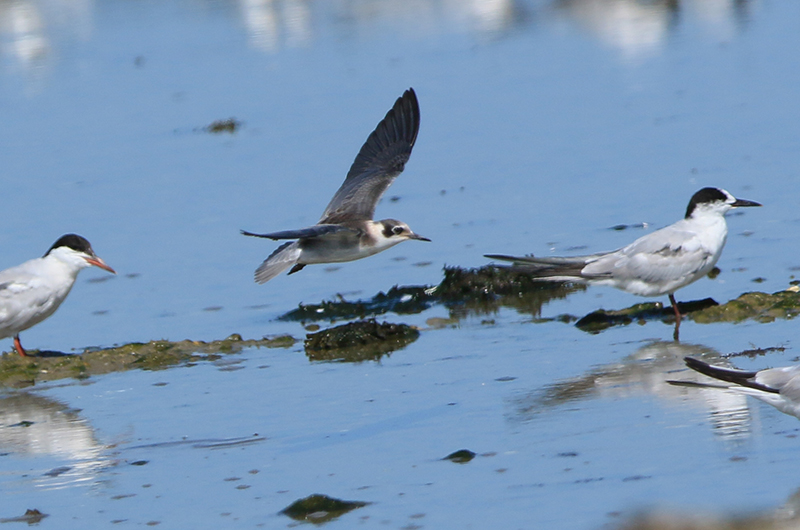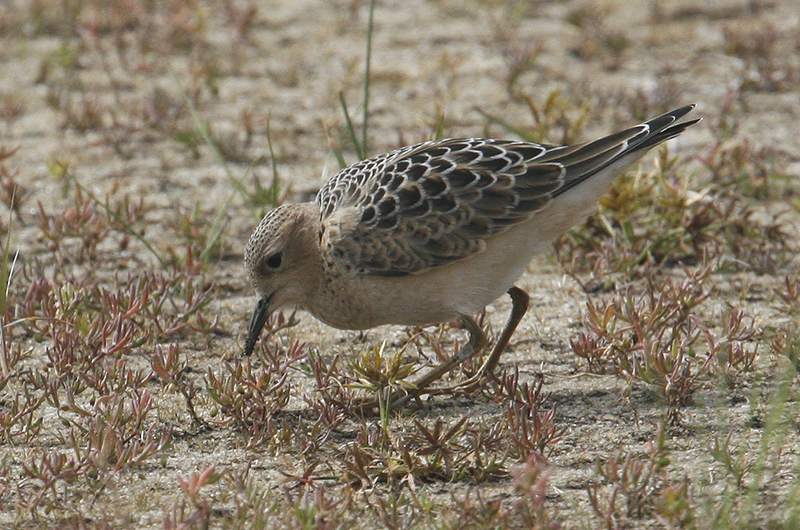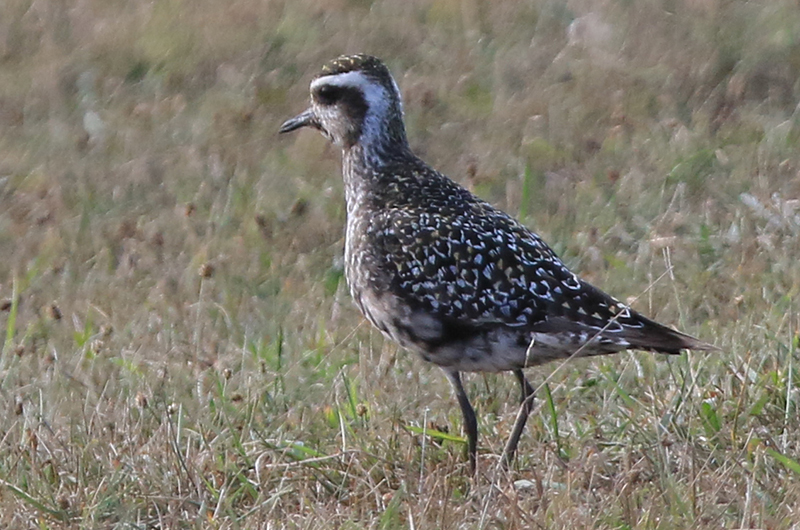It’s about time. We have been waiting for a few species of shorebirds that generally show up in August. Well, sure enough, here they are.
American golden plovers look a lot like black-bellied plovers but they are more likely found on short-cropped pastures than on tidal flats. Lanny McDowell spotted two golden plovers in a Katama pasture on August 31, and Ken Magnuson found them there again on Sept. 2.
Phillip Edmundson found a buff-breasted sandpiper foraging along the southern shoreline of Watcha Pond on Sept. 1. Steve Allen also spotted one on August 30 at Felix Neck.
There are two sandpipers with a very pointed appearance because their wings extend past their tails they are very difficult to identify! On August 31, Jeff Peters found the less common of the two, a Baird’s sandpiper, on Norton Point Beach. The other one, a white-rumped sandpiper, has been here a bit longer. Walt Looney was the first to see one back on August 12, at Little Beach. Luanne Johnson and Pete Gilmore co-led my August 25 guided birding tour, and spotted two of them on Little Beach. Then, on August 28, Merril and Andrew Eppidio spotted one on Norton Point Beach.
Andrew and Merril Eppidio also spotted black terns twice, once on August 28 at Little Beach and again on August 30 on Cape Pogue. There were two black terns at Little Beach over the Labor Day weekend, and Lanny McDowell spotted one on Sarson’s Island on Sept. 2.
Little Beach was the place to go over the Labor Day weekend. Seven birders were there at different times: Warren Woessner, Walt Looney, Lanny McDowell, Jeff Bernier, Doreen and Dennis McCabe, and my Sept. 1 guided birding tour. On Sept 1 and 2 we found 250 double-crested cormorants, at least 700 common terns (some were roosting while many others were flying out into Nantucket Sound to forage), 100 roseate terns, two black terns, one American golden plover, 20 greater yellowlegs, five lesser yellowlegs, four piping plovers, three American oystercatchers, 10 black bellied plovers, 21 semipalmated plovers, 15 ruddy turnstones, 10 least sandpipers, 20 semipalmated sandpipers, 30 sanderling, one osprey, one red-tailed hawk (perched on the dormer of a house along Fuller street), one cedar waxwing, three tree swallows, 60 herring gulls, 10 ring-billed gulls, five great black-backed gulls, 20 laughing gulls, and a non-breeding plumage Bonaparte’s gull.
Wow, 24 species. Notable for their absence were the 14 black skimmers that have been observed there throughout August, and the usually vocal and conspicuous willets.
A solitary sandpiper — yes, there was only one of them — was found at James Pond on August 27 by Pete Gilmore. He also spotted two whimbrel flying over James Pond on August 30.
The numbers of black skimmers on Norton Point has built up to at least 56, as reported by Merrill Eppedio on August 28 and Dennis and Doreen McCabe on August 29.
On August 21 on Norton Point, Walt Looney found a northern harrier, the black skimmers, black-bellied plovers, two short-billed dowitchers, oystercatchers, ruddy turnstones, willets and sanderlings. He also reports that seven killdeer were alongside the pond at Sweetened Water Preserve. Sarah Mayhew also spotted the short-billed dowitchers on August 31.
Not all the action is at Little Beach or Norton Point. Both James and Watcha Ponds are mentioned above, and from the southern end of Sengekontacket Pond comes Dahlia Rudavsky’s report of two great egrets, a great blue heron, three lesser yellowlegs, three oystercatchers, six semipalmated plovers, and an osprey on Sept. 2. And from Squibnocket Beach, Sarah Cook reports semipalmated plovers, sanderlings, ruddy turnstones, least sandpipers and an osprey on Sept. 1. From Felix Neck, Steve Allen reports a juvenile yellow-crowned night-heron on Sept. 2.
From near Chocker’s Lane on August 28, Chris Daly reports observing a feeding frenzy of more than 100 cormorants, dozens of laughing gulls, and a dozen great egrets. In this feeding frenzy — so called because the action is frenetic — the schooling bait fish are forced to the surface by the diving cormorants, where they are subject to attack by the other species. This is interesting to observe unless you are a schooling bait fish! There were also eight oystercatchers nearby.
But waterbirds are not the only migrants. On Sept. 2, Matt Pelikan kayaked Crab Creek and Black Point Pond. His most interesting sighting was a marsh wren, a small wren that we find at this time of the year only. He also spotted nine green herons, two great blue herons, and one great egret.
Steve Miller reports seeing the first peregrine falcon of the season twice, once when sailing in Edgartown on August 30, and again from Edgartown Bay Road on Sept 2.
Susan Whiting, Allan Keith and Pete Gilmore headed up to Gay Head morraine, where they spotted the usual woodland residents plus hairy woodpecker, flicker, eastern wood-pewee, great crested flycatcher, and red-eyed vireo. They then visited Squibnocket, where their highlights were red-breasted nuthatch, common yellowthroat, yellow warbler, and prairie warbler. Pete Gilmore also reports red-breasted nuthatches on August 24 at West Chop Woods, and I heard several at Waterview Farm on Sept. 1. Great crested flycatchers have also been reported by Bob Morse in Dodger’s Hole on Sept. 2, and I saw three of them — one at my house on Sept. 1 and two at Cedar Tree Neck on Sept. 2. These are migrants as this species has been missing for a while.
Maggie Bresnahan and Daisy Kimberly both observed Baltimore orioles in their yards on August 28. And Steve Allen observed one at Felix Neck on August 24.
Kate Waters spotted a leucistic downy woodpecker youngster on August 26 at the Edgartown School. It was mostly gray and white, with no black visible.
Happy Spongberg had a covey of 10 bobwhites in her yard on August 25.
Eastern meadowlarks used to be common on the Vineyard, but no more. So it is exciting that Nancy Weaver, Greg Palermo and state botanist Bob Wernerehl spotted one at Katama Airpark on August 28. I saved this for last because this species is now rare partly because of habitat loss and the superabundance of small and medium-sized predators, a topic discussed in last week’s column. Unfortunately, I did not include cats, both feral and domestic. Cats are introduced predators that are highly efficient hunters, and even well-fed cats hunt and catch small birds and mammals. These cats are one of the top human-caused threats to wildlife. Studies have shown that they kill approximately 2.4 billion birds every year in North America.
Southbound shorebirds migrants are showing up. Please report all your sightings to birds@mvgazette.com.
Robert Culbert leads Saturday morning Guided Birding Tours and is an ecological consultant living in Vineyard Haven.











Comments (1)
Comments
Comment policy »